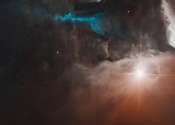In nuclear physics and nuclear chemistry, nuclear fusion is the process by which multiple like-charged atomic nuclei join together to form a heavier nucleus. It is accompanied by the release or absorption of energy, which allows matter to enter a plasma state.
The fusion of two nuclei with lower mass than iron (which, along with nickel, has the largest binding energy per nucleon) generally releases energy while the fusion of nuclei heavier than iron absorbs energy; vice-versa for the reverse process, nuclear fission. In the simplest case of hydrogen fusion, two protons have to be brought close enough for their mutual electric repulsion to be overcome by the nuclear force and the subsequent release of energy.
Nuclear fusion occurs naturally in stars. Artificial fusion in human enterprises has also been achieved, although has not yet been completely controlled. Building upon the nuclear transmutation experiments of Ernest Rutherford done a few years earlier, fusion of light nuclei (hydrogen isotopes) was first observed by Mark Oliphant in 1932; the steps of the main cycle of nuclear fusion in stars were subsequently worked out by Hans Bethe throughout the remainder of that decade. Research into fusion for military purposes began in the early 1940s as part of the Manhattan Project, but was not successful until 1952. Research into controlled fusion for civilian purposes began in the 1950s, and continues to this day.









